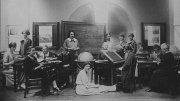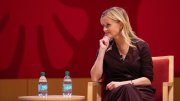It is a Harvard story within a Harvard story: screenwriter Graham Sack ’03 and producer Jennifer 8. Lee ’99, two College-trained scientists-turned-filmmakers, have developed a television series about the Harvard Computers, a team of women who mapped the night sky while working at the Harvard College Observatory during the late nineteenth and early twentieth centuries. The women analyzed photographic plates of the stars, and across the years they helped uncover galaxies and nebulae and created methods for measuring distance in space. They were also paid a fraction of what their male colleagues earned (in both wages and respect), and although they became famous in their own lifetimes, their contributions were mostly forgotten in the century that followed. “I had lectures in the Harvard Observatory when I was an undergraduate,” says Sack, who considered concentrating in astrophysics before settling on physics instead. “That building remains a bit of a museum to the Harvard Computers, and that was where I first encountered some of the fragments of the stories about the women.”

Jennifer 8. Lee and Graham Sack
Photography courtesy of Jennifer 8. Lee and Graham Sack.
He and Lee began exploring the idea of turning those stories into a series several years ago, amid the earliest rumblings of the #MeToo movement and a growing reevaluation of the role of women in STEM fields. Science author Dava Sobel’s 2016 book on the Harvard Computers, The Glass Universe, and the 2017 discovery of thousands more pages of the women’s notebooks in the Harvard archives, provided new information about their work and personal lives. To Sack and Lee, this history lends itself to a different kind of science narrative than the lone-genius depiction commonly presented in films about scientists and mathematicians like Alan Turing, John Nash, and Marie Curie.
By contrast, the Harvard Computers’ work was an ensemble effort of day-to-day science, spanning decades and generations. It began in the late 1870s with Williamina Fleming, a newly arrived Scottish immigrant who worked as a maid for the Harvard observatory’s director, Edward C. Pickering. Impressed with her intellect, he hired her for the observatory staff as the first “computer” there, analyzing glass-plate images produced by the telescope’s camera. Pickering recruited other women to join her; before long Fleming was supervising a staff of dozens. Between about 1880 and the mid 1920s, about 80 Harvard Computers in total worked at the observatory, and increasingly, as time went on, the women who came to the observatory were themselves specialists in the field—accomplished theoreticians like Annie Jump Cannon and Henrietta Swan Leavitt, whose developments and discoveries altered the way astronomy was practiced.
“And so there’s a kind of beachhead-in-science structure that also begins to allow the women to move up the chain of status and significance within science as a profession,” Sack says, “and in that way, they’re laying the groundwork for each other. Each woman is setting up a foothold for the next.” That part of the story also sets up one of the series’ major arcs, Lee adds, revolving around the issue of recognition in science: “who gets credit for what kind of discovery in science. And that obviously isn’t just an issue with the Harvard Computers, but actually repeats over and over again throughout history.”

Harvard Computers at work in 1898—Williamina Fleming is standing at the back.
Photograph courtesy of the Harvard Library Archives
The time period also overlaps with big social changes—women’s suffrage, immigration, the labor movement—as well as very local ones: “Our second season is centered around 1885,” Sack says, “when Radcliffe starts to graduate its first female science graduates, and they have nowhere to go. The observatory was one of the few places that was willing and interested in hiring women with undergraduate degrees in science.”
Earlier this year, the planned series got a boost when the Sundance Institute named Sack and Lee recipients of a Sloan Episodic Fellowship. The pair will spend part of the summer working with science and creative advisers to refine and further develop their script, and make sure its scientific grounding is solid, before pitching it to distributors. “This is sort of our dream acknowledgement for this project,” Lee says. Similar fellowships and grants from the Sloan Foundation have supported science-related films like Hidden Figures, The Imitation Game, Tesla, The Martian, and First Man. “Sloan has such a history of high-caliber realistic portrayals of science and scientists,” Lee says. “It’s a great encouragement for us.”
This project is not the first together for Sack and Lee, whose collaborative energy springs partly from a shared diversity in their professional backgrounds. Sack became an actor on Broadway at age 10, and as a physics student years later at Harvard, he was also interested in film and television and active in the Harvard Radcliffe Dramatic Club. After college, he began screenwriting, and in 2015 a romantic comedy he cowrote, Septillion to One, made it onto the Black List (created by Franklin Leonard ’00); he has also created virtual- and augmented-reality films and installations. This past winter, he defended his dissertation in digital humanities at Columbia.
Lee’s path is similarly kaleidoscopic. A Ledecky Undergraduate Fellow at this magazine who concentrated in applied mathematics and economics, she worked as a reporter for The New York Times and wrote a 2008 best-selling book, The Fortune Cookie Chronicles, which took a deep dive into the history of Chinese food. From there, she expanded into documentaries—The Search for General Tso, about Chinese-American food, and Picture Character, about the world of emojis (currently vice president of the Unicode Consortium’s emoji subcommittee, she also calls herself an “emoji activist”). A few years ago, she co-founded Plympton, a literary digital-publishing studio, through which she has collaborated with Sack. Most notably, they worked together in 2017 on Lincoln in the Bardo, a virtual-reality experience for The New York Times, adapted from the George Saunders novel of the same name. Sack wrote and directed the film; Lee was its producer.
The two see their current project as a layered work of art long in the making. “There’s kind of a core metaphor that sits at the bottom of this series, around visibility and invisibility,” Sack says. “That plays up clearly in terms of these women, who for probably a hundred years were largely invisible to history, even though they were doing most of the hard, empirical work that major discoveries were based on.” But the metaphor also gets at something else: the work itself, “which was to discover the invisible objects in the night sky,” Sack says. “You know, when they began, there were about 2,000 stars that were known.” By the time they were done, 40 years later, there were 400,000. “So that work of recovering things that have always been there, but are invisible due to our limited perspective at a given moment, is a kind of central metaphor.” It’s also what the series itself is trying to do: “to make these women visible again, as participants in the history of science.”









